24 Mar Solace in Steel with Elmer Roush
This week for our celebration...

This week for our celebration...
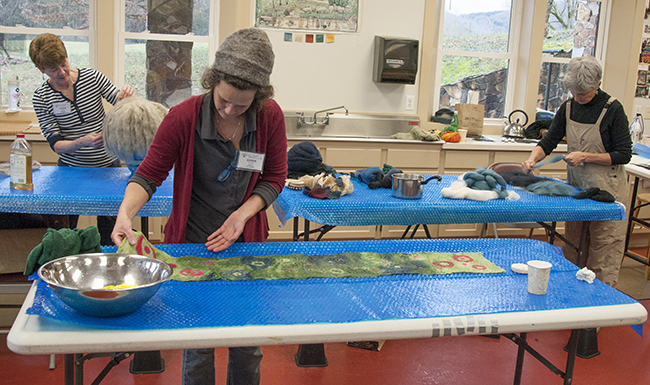 Students in Kay Patterson's "Needle, Nuno, and Wet–Feltmaker's Sampler" class learned all about different kinds of felting making. Many of us in the class found a love for making felting hats. By the end of the week, we were our own fashion show around campus with whimsical colorful creations on our heads. Enjoy these photos from our week!
Students in Kay Patterson's "Needle, Nuno, and Wet–Feltmaker's Sampler" class learned all about different kinds of felting making. Many of us in the class found a love for making felting hats. By the end of the week, we were our own fashion show around campus with whimsical colorful creations on our heads. Enjoy these photos from our week!
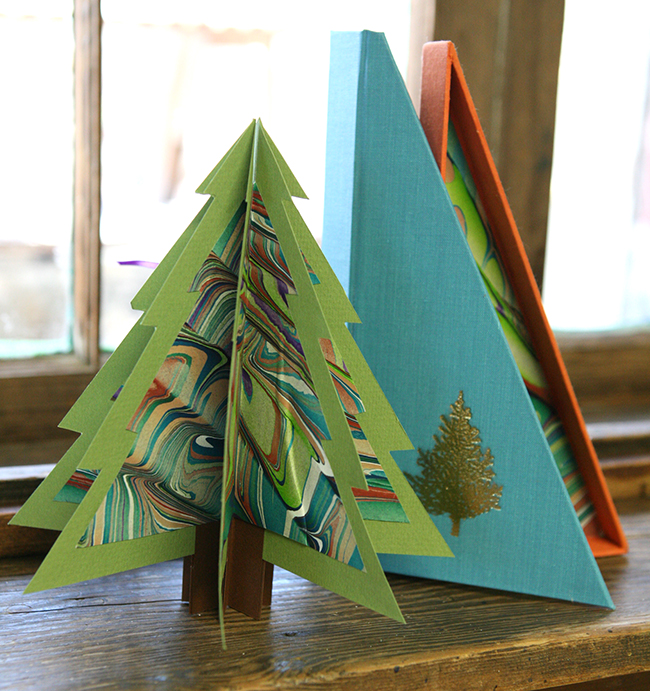 My Christmas tree book & box[/caption]
In the Book Arts class, "Ornamental Books and Boxes for the Holidays" with Dea Sasso we tackled three ambitious projects for the Long Weekend.
The first project was the tree pictured above with a fancy triangular box. Dea bought a wonderful assortment of papers, book cloth, and leather and everyone picked a combination of colors. My tree fits into a blue box with gold tooled stars and a tree on the front.
My Christmas tree book & box[/caption]
In the Book Arts class, "Ornamental Books and Boxes for the Holidays" with Dea Sasso we tackled three ambitious projects for the Long Weekend.
The first project was the tree pictured above with a fancy triangular box. Dea bought a wonderful assortment of papers, book cloth, and leather and everyone picked a combination of colors. My tree fits into a blue box with gold tooled stars and a tree on the front.
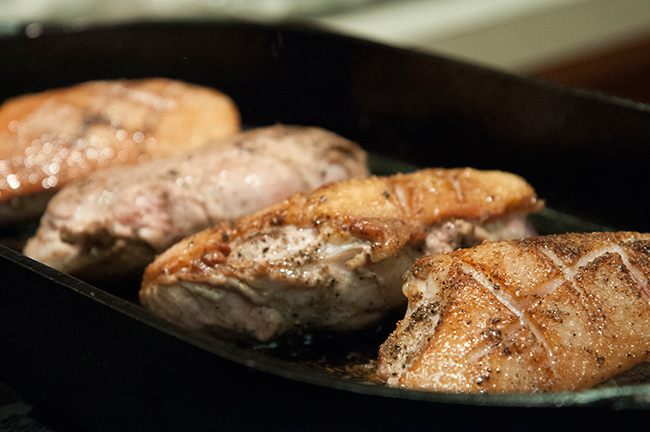 Juicy, tender duck breast in the cast iron pot[/caption]
Halloween weekend brought delicious dismemberment to the Folk School. Don’t panic! All the butchery occurred under the expert tutelage of Mark Rosenstein in the Cooking Studio for the class “Whole Bird Weekend,” where students learned advanced techniques for preparing duck, chicken, and turkey for maximum flavor and juiciness.
[caption id="attachment_13953" align="aligncenter" width="600"]
Juicy, tender duck breast in the cast iron pot[/caption]
Halloween weekend brought delicious dismemberment to the Folk School. Don’t panic! All the butchery occurred under the expert tutelage of Mark Rosenstein in the Cooking Studio for the class “Whole Bird Weekend,” where students learned advanced techniques for preparing duck, chicken, and turkey for maximum flavor and juiciness.
[caption id="attachment_13953" align="aligncenter" width="600"]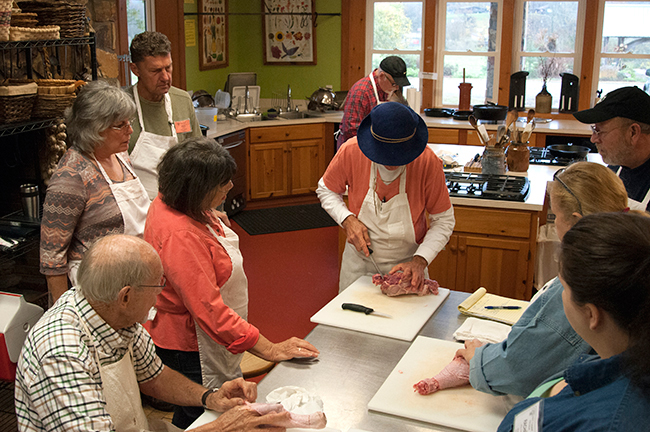 Mark demonstrates how to debone a turkey leg[/caption]
[caption id="attachment_13955" align="aligncenter" width="600"]
Mark demonstrates how to debone a turkey leg[/caption]
[caption id="attachment_13955" align="aligncenter" width="600"]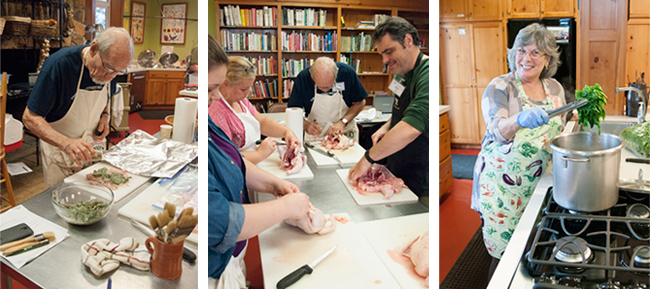 Jerry adds flavor with thyme and marjoram / Students work on deboning a chicken / Sheila blanches spinach for the stuffing.[/caption]
Mark Rosenstein is a critically acclaimed veteran restaurateur who has been running restaurants in the WNC for over 40 years. Mark's cooking is based on local, seasonal ingredients and his current passion is cooking with fire. His newest project, the Smoky Park Supper Club in the River Arts District in Asheville, features wood-fired, seasonal, farm-to-table cuisine. If you are interested in wood-fired cooking, check out Mark’s upcoming January Folk School class: Wood-fired Cookery - Breads, Meats, and Vegetables.
Jerry adds flavor with thyme and marjoram / Students work on deboning a chicken / Sheila blanches spinach for the stuffing.[/caption]
Mark Rosenstein is a critically acclaimed veteran restaurateur who has been running restaurants in the WNC for over 40 years. Mark's cooking is based on local, seasonal ingredients and his current passion is cooking with fire. His newest project, the Smoky Park Supper Club in the River Arts District in Asheville, features wood-fired, seasonal, farm-to-table cuisine. If you are interested in wood-fired cooking, check out Mark’s upcoming January Folk School class: Wood-fired Cookery - Breads, Meats, and Vegetables.
 The class display at Show and Tell (2013)[/caption]
If you are looking for a unique class at the Folk School that incorporates visual art, mixed media, and performance into a week of puppet fun, check out David Stephens' class Hand-and-Rod Puppet Construction (April 10-16, 2016). When David teaches his class, an infectious feeling of whimsy, fun, and joyful energy permeates the campus. David has been a puppeteer and puppet maker for over 20 years and is founder of All Hands Productions in Atlanta, GA. I sat down with David during his last class here at the Folk School to find out a little more about the magic of puppetry.
[caption id="attachment_13855" align="alignright" width="249"]
The class display at Show and Tell (2013)[/caption]
If you are looking for a unique class at the Folk School that incorporates visual art, mixed media, and performance into a week of puppet fun, check out David Stephens' class Hand-and-Rod Puppet Construction (April 10-16, 2016). When David teaches his class, an infectious feeling of whimsy, fun, and joyful energy permeates the campus. David has been a puppeteer and puppet maker for over 20 years and is founder of All Hands Productions in Atlanta, GA. I sat down with David during his last class here at the Folk School to find out a little more about the magic of puppetry.
[caption id="attachment_13855" align="alignright" width="249"]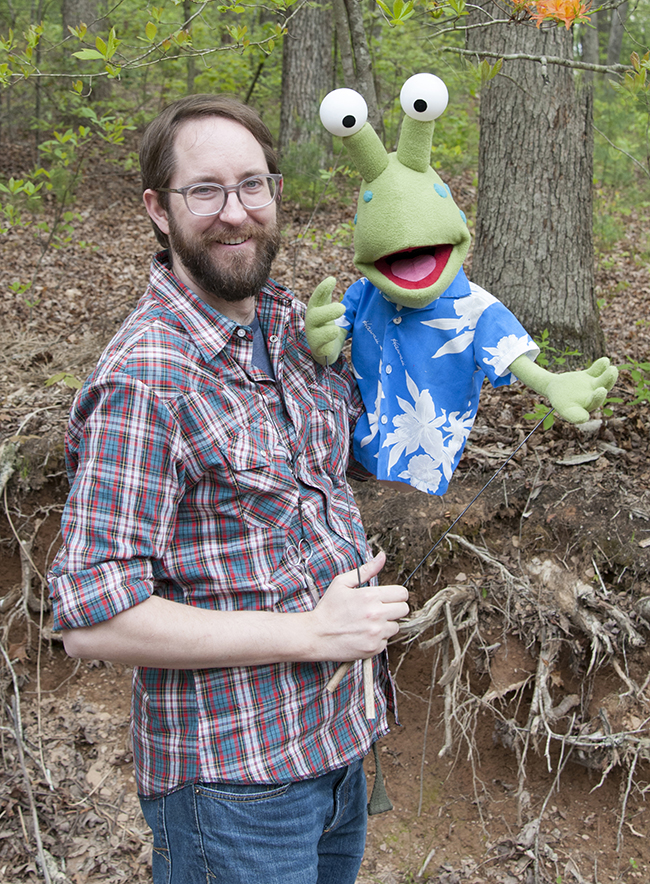 David with his new alien creation[/caption]
CP: Is the person who creates the puppet usually the puppeteer?
DS: Some people are just builders, and some people are just performers. I do both and I feel like I am a more informed builder, because I am a performer, and vice versa. Understanding the mechanics of how the puppet is made makes me a better performer. Thinking like a performer makes me a better builder, because I know what I want the puppet to be able to do. It can be a symbiotic relationship.
I like the visual art aspect just as much as the performance part. Making a puppet from scratch is very gratifying. You take this idea in your head and realize it in three dimensions, which is pretty cool.
CP: Describe what a week is like in your Hand-and-Puppet Construction class.
DS: For the first few days, everybody is making the same basic form. By the end of the week, students are creating their own characters, using their imaginations to come up with different facial feature combinations. The personalities of the puppets start to come out later in the week. You see this extreme change in the room from things that look very much the same, to very distinct looking characters.
The difference between the puppets that I make and the puppets that these students make is about 20 years of experience. We are all working with the same basic pattern. Experience is the only difference; otherwise we are making the puppets from exactly the same patterns and materials.
David with his new alien creation[/caption]
CP: Is the person who creates the puppet usually the puppeteer?
DS: Some people are just builders, and some people are just performers. I do both and I feel like I am a more informed builder, because I am a performer, and vice versa. Understanding the mechanics of how the puppet is made makes me a better performer. Thinking like a performer makes me a better builder, because I know what I want the puppet to be able to do. It can be a symbiotic relationship.
I like the visual art aspect just as much as the performance part. Making a puppet from scratch is very gratifying. You take this idea in your head and realize it in three dimensions, which is pretty cool.
CP: Describe what a week is like in your Hand-and-Puppet Construction class.
DS: For the first few days, everybody is making the same basic form. By the end of the week, students are creating their own characters, using their imaginations to come up with different facial feature combinations. The personalities of the puppets start to come out later in the week. You see this extreme change in the room from things that look very much the same, to very distinct looking characters.
The difference between the puppets that I make and the puppets that these students make is about 20 years of experience. We are all working with the same basic pattern. Experience is the only difference; otherwise we are making the puppets from exactly the same patterns and materials.
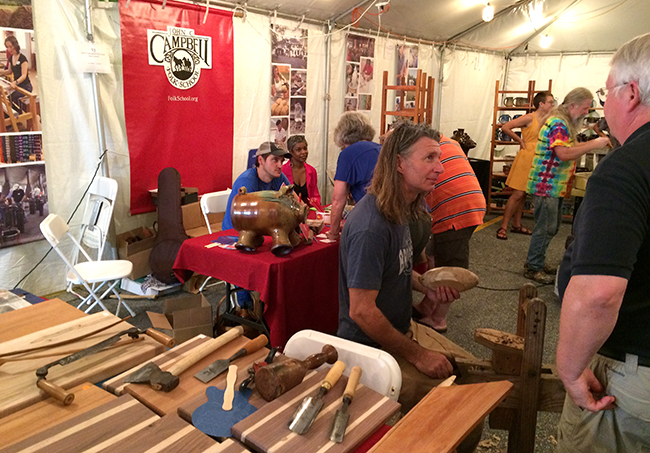 Our Folk School booth at the 75th National Folk Festival in Greensboro, NC[/caption]
Our Folk School booth at the 75th National Folk Festival in Greensboro, NC[/caption]
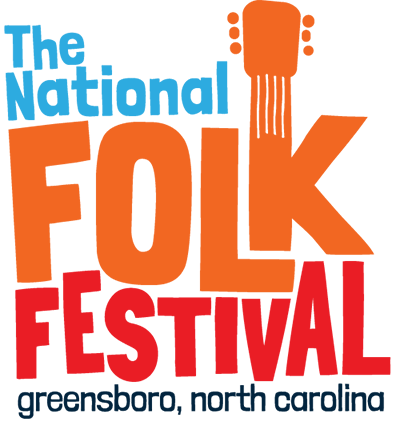 We had a great time this past weekend representing the Folk School at the 75th National Folk Festival. This was the 1st year (of a 3-year residency) that the Folk Fest was hosted in the city of Greensboro, NC. The event featured performances and demonstrations by over 300 of the nation’s finest musicians, dancers, and craftspeople.
We hope to see you next year. Save the dates for this awesome festival in an awesome town. The 76th National Folk Festival dates are September 9-11, 2016!
[caption id="attachment_13736" align="aligncenter" width="600"]
We had a great time this past weekend representing the Folk School at the 75th National Folk Festival. This was the 1st year (of a 3-year residency) that the Folk Fest was hosted in the city of Greensboro, NC. The event featured performances and demonstrations by over 300 of the nation’s finest musicians, dancers, and craftspeople.
We hope to see you next year. Save the dates for this awesome festival in an awesome town. The 76th National Folk Festival dates are September 9-11, 2016!
[caption id="attachment_13736" align="aligncenter" width="600"]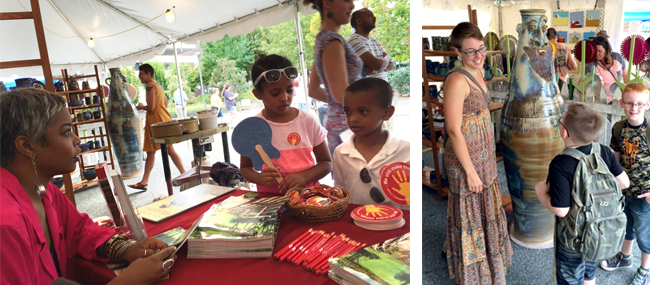 Kisha joined the JCCFS team this weekend / Rob sold his gigantic jug to a face jug collector.[/caption]
Kisha joined the JCCFS team this weekend / Rob sold his gigantic jug to a face jug collector.[/caption]
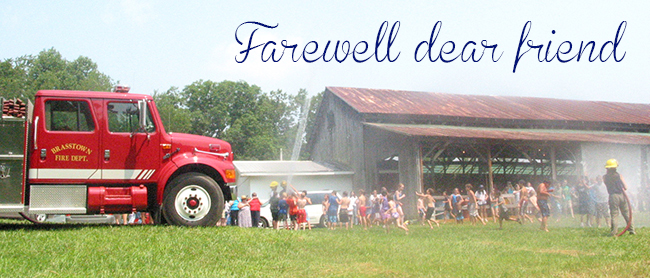
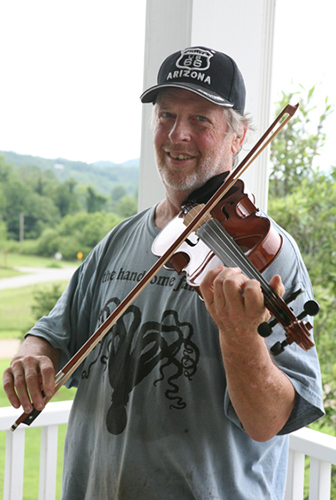 We are mourning the loss of our dear friend, JD Robinson. JD played an integral part in the music and dance community at the Folk School for decades. He taught music classes in a wide variety of instruments, engaged students at morningsong with songs and tales of fire safety, played for contra dances, led jams, and was involved in Winter Dance Week. JD also kept the community of Brasstown safe as the Fire Chief of the Brasstown Volunteer Fire Department. Always a phone call away, he always came to help whenever there was an emergency at the Folk School. He will be greatly missed.
Folks gathered at the Festival Barn on Saturday, August 22, 2015 at 1 p.m. for a celebration of the life of JD. There was a procession, an official Firefighter's Last Call, potluck meal & music. The Brasstown Fire Department and many others brought JD's ashes to the Barn.
We are mourning the loss of our dear friend, JD Robinson. JD played an integral part in the music and dance community at the Folk School for decades. He taught music classes in a wide variety of instruments, engaged students at morningsong with songs and tales of fire safety, played for contra dances, led jams, and was involved in Winter Dance Week. JD also kept the community of Brasstown safe as the Fire Chief of the Brasstown Volunteer Fire Department. Always a phone call away, he always came to help whenever there was an emergency at the Folk School. He will be greatly missed.
Folks gathered at the Festival Barn on Saturday, August 22, 2015 at 1 p.m. for a celebration of the life of JD. There was a procession, an official Firefighter's Last Call, potluck meal & music. The Brasstown Fire Department and many others brought JD's ashes to the Barn.
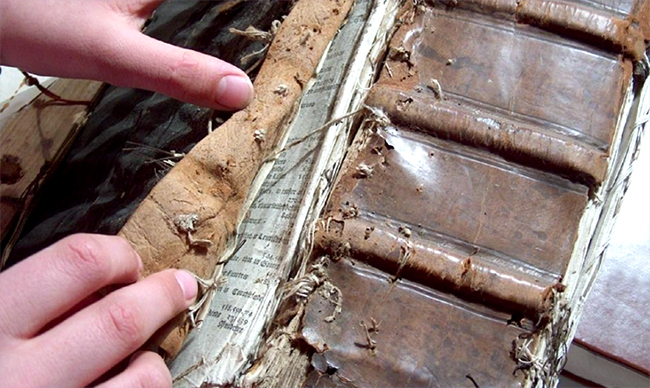 A rare book in need of restoration[/caption]
[caption id="attachment_13546" align="alignright" width="212"]
A rare book in need of restoration[/caption]
[caption id="attachment_13546" align="alignright" width="212"]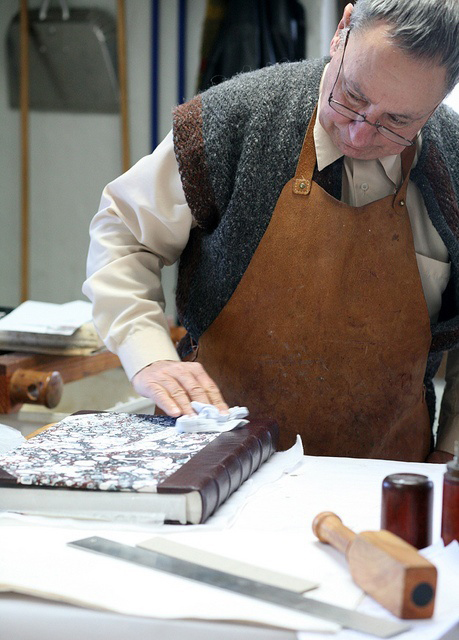 Gian Frontini teaching in Lower Keith House Studio[/caption]
Gian Frontini has taught book making and restoration at the Folk School for many years. He runs a small bindery in Amherst Island, Ontario, and concentrates on restoration and conservation of early leather and vellum bindings. I talked Gian about his upcoming class: Book Restoration Clinic, about book making, the Folk School, and more. Enjoy our interview!
CP: Tell me about yourself. Where are you from, and what originally brought you to Brasstown?
GF: I live on an island in Lake Ontario with my wife Pat, who is professional potter and weaver. Amherst Island is a wonderful and peaceful place, ideal to lose yourself in your craft. My wife is English and I am Italian. We both came to Canada 50 years ago. I was employed in an international company and Canada is the place we loved the most of everywhere I worked all over the world. Brasstown came into our life when Pat met Martha Owen in 1999 at a spinners' conference. The next year we came to the school, and since then it has become a bigger, and bigger part of our life.
[caption id="attachment_13544" align="alignright" width="272"]
Gian Frontini teaching in Lower Keith House Studio[/caption]
Gian Frontini has taught book making and restoration at the Folk School for many years. He runs a small bindery in Amherst Island, Ontario, and concentrates on restoration and conservation of early leather and vellum bindings. I talked Gian about his upcoming class: Book Restoration Clinic, about book making, the Folk School, and more. Enjoy our interview!
CP: Tell me about yourself. Where are you from, and what originally brought you to Brasstown?
GF: I live on an island in Lake Ontario with my wife Pat, who is professional potter and weaver. Amherst Island is a wonderful and peaceful place, ideal to lose yourself in your craft. My wife is English and I am Italian. We both came to Canada 50 years ago. I was employed in an international company and Canada is the place we loved the most of everywhere I worked all over the world. Brasstown came into our life when Pat met Martha Owen in 1999 at a spinners' conference. The next year we came to the school, and since then it has become a bigger, and bigger part of our life.
[caption id="attachment_13544" align="alignright" width="272"]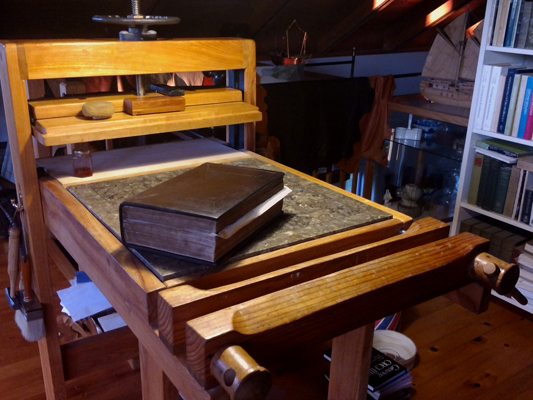 Gian's South Shore Bindery on Amherst Island[/caption]
CP: I know you have a cabin very close to the Folk School. Do you spend some of the year here?
GF: We spend three months of the year here, usually in the fall and spring. The summers are too lovely on Amherst Island and I love the fierce frozen wastes of the Northern winters. It is incredible that we have the choice of such lovely places.
CP: Why do you like teaching at the Folk School?
GF: The Folk School is an unique sharing experience for both teachers and students. It is rare to find a place where you can freely exchange ideas and knowledge. I love teaching at the Folk School because I learn from the students and make so many good friends.
Gian's South Shore Bindery on Amherst Island[/caption]
CP: I know you have a cabin very close to the Folk School. Do you spend some of the year here?
GF: We spend three months of the year here, usually in the fall and spring. The summers are too lovely on Amherst Island and I love the fierce frozen wastes of the Northern winters. It is incredible that we have the choice of such lovely places.
CP: Why do you like teaching at the Folk School?
GF: The Folk School is an unique sharing experience for both teachers and students. It is rare to find a place where you can freely exchange ideas and knowledge. I love teaching at the Folk School because I learn from the students and make so many good friends.
David Baker lights up any...
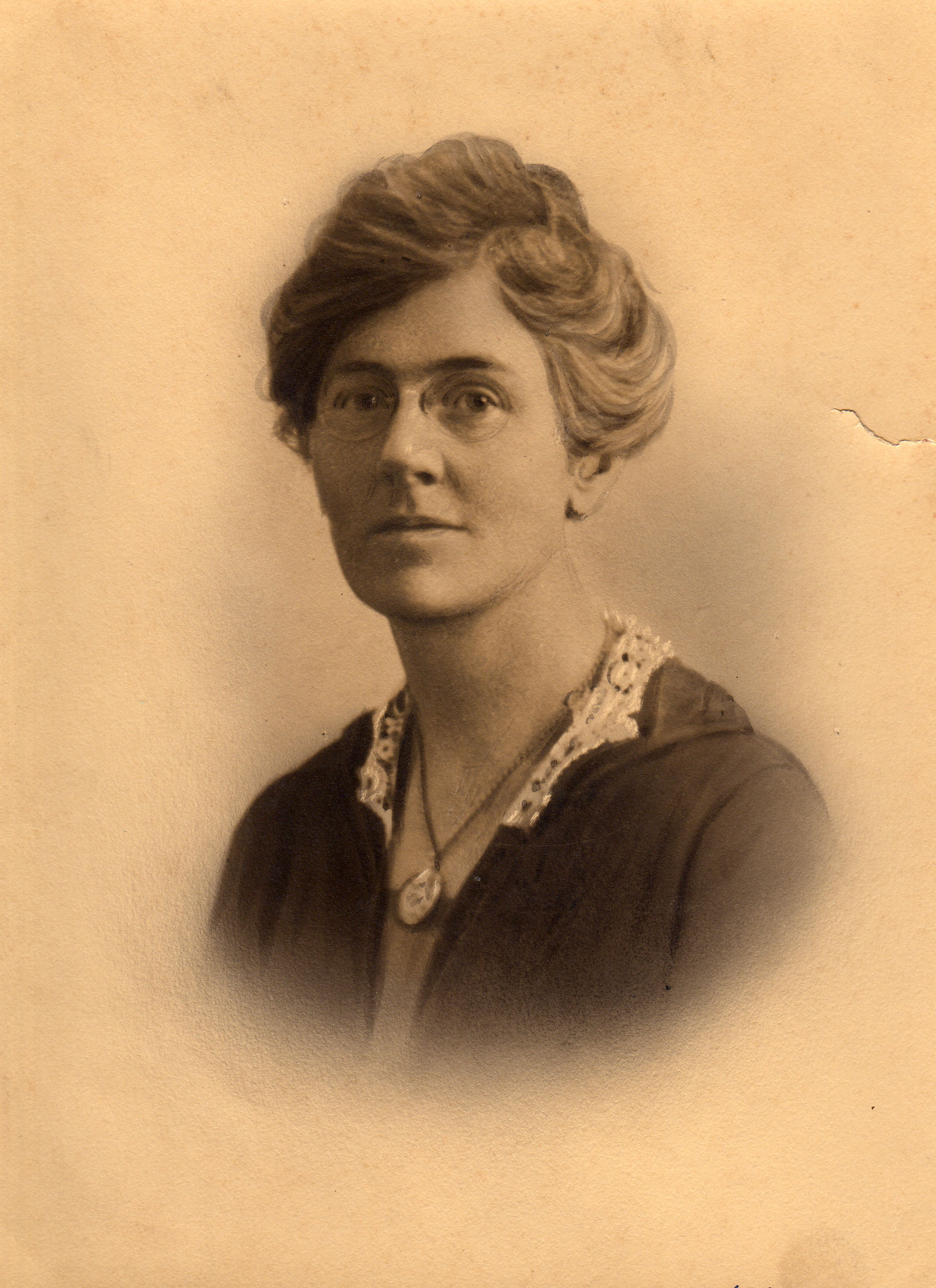 Olive Dame Campbell[/caption]
Olive Dame was born the daughter of a middle class New England family of Mayflower descent. Her father was a talented botany teacher and school principal. A gifted mother taught her early the love of art and music. She enjoyed an active, rich youth that developed an inquiring mind and strong, determined will. These attributes would serve her well in the coming years of adventure with future husband, John C. Campbell, and later as the founder and director of the Folk School she named in his honor. Though less well known, she became one of the leading social reformers of her time.
After graduating from Tufts College in 1903, she taught literature several years before planning a vacation voyage to Scotland in 1906. On the voyage, she met John Campbell who was traveling to his ancestral homeland to recuperate from the loss of a wife and the stress of being President of Piedmont College. Olive was a smart, talented and dedicated Christian woman with a great sense of humor. She had indeed been called to serve humanity through education. In these ways, she was a lot like John. By trip’s end, they were engaged. Olive and John married in 1907 in her home town in Medford, Massachusetts.
Olive Dame Campbell[/caption]
Olive Dame was born the daughter of a middle class New England family of Mayflower descent. Her father was a talented botany teacher and school principal. A gifted mother taught her early the love of art and music. She enjoyed an active, rich youth that developed an inquiring mind and strong, determined will. These attributes would serve her well in the coming years of adventure with future husband, John C. Campbell, and later as the founder and director of the Folk School she named in his honor. Though less well known, she became one of the leading social reformers of her time.
After graduating from Tufts College in 1903, she taught literature several years before planning a vacation voyage to Scotland in 1906. On the voyage, she met John Campbell who was traveling to his ancestral homeland to recuperate from the loss of a wife and the stress of being President of Piedmont College. Olive was a smart, talented and dedicated Christian woman with a great sense of humor. She had indeed been called to serve humanity through education. In these ways, she was a lot like John. By trip’s end, they were engaged. Olive and John married in 1907 in her home town in Medford, Massachusetts.


